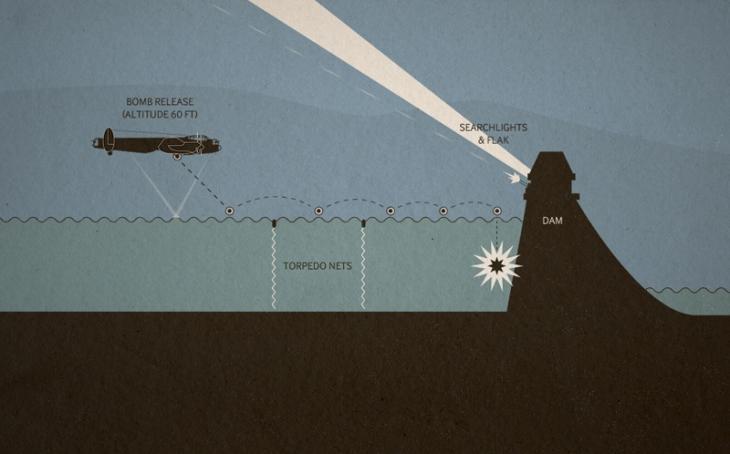On the night of 16-17 May 1943, Wing Commander Guy Gibson led 617 Squadron of the Royal Air Force on an audacious bombing raid to destroy three dams in the Ruhr valley, the industrial heartland of Germany. The mission was codenamed Operation 'Chastise'.
The dams were fiercely protected. Torpedo nets in the water stopped underwater attacks and anti-aircraft guns defended them against enemy bombers.
But 617 Squadron had a secret weapon: the 'bouncing bomb'.
The targets

The Möhne dam in Germany's Ruhr valley secured the water supply for much of the surrounding area. Water from its reservoir was also used to generate electricity. It was thought that destruction of this dam and others in the region would cause massive disruption to German war production. Plans for an attack on the dams had first been considered in 1937, but it took until 1942 to develop a weapon capable of destroying the dams - and the aircraft to deliver it.
A breakthrough in the back garden

In 1942 British engineer Barnes Wallis began working on plans for a bomb that could skip across water. He developed the idea by experimenting with bouncing marbles across a water tub in his back garden. Wallis thought the new weapon could be used to attack moored battleships, but research soon focused on using it against the dams that were vital to German industry.
Perfecting the technique

The Admiralty and the RAF carried out extensive tests at sites around the country. These revealed that the drum-shaped bomb (codenamed 'Upkeep') needed to be dropped from a height of 60 feet (18m), and at a ground speed of 232mph. The bomb would spin backwards across the surface of the water before reaching the dam. Its residual spin would then drive the bomb down the wall of the dam before exploding at its base. All that was needed now was men to fly specially modified Lancaster bombers which would carry the 'Upkeep'.
The squadron comes together

In late March 1943, a new squadron was formed to carry out the raid on the dams. Initially codenamed Squadron X, 617 Squadron was led by 24-year old Wing Commander Guy Gibson (pictured in door of aircraft) and was made up of aircrew from Britain, Canada, Australia, New Zealand and the USA. With one month to go before the raid, and with only Gibson knowing the full details of the operation, the squadron began intensive training in low-level night flying and navigation. They were ready for Operation 'Chastise'.
The plan

The three main targets were the Möhne, Eder and Sorpe dams.The Möhne dam was a curved 'gravity' dam and was 40m high and 650m long. There were tree-covered hills around the reservoir, but any attacking aircraft would be exposed on the immediate approach. The Eder dam was of similar construction but was an even more challenging target. Its winding reservoir was bordered by steep hills. The only way to approach would be from the north. The Sorpe was a different type of dam and had a watertight concrete core 10m wide. At each end of its reservoir the land rose steeply, and there was also a church spire in the path of the attacking aircraft.
The night of the raid

From 9.28pm on 16 May, 133 aircrew in 19 Lancasters took off in three waves to bomb the dams. Gibson was flying in the first wave and his aircraft was first to attack the Möhne (pictured here) at 12.28am, but five aircraft had to drop their bombs before it was breached. The remaining aircraft still to drop their bombs then attacked the Eder, which finally collapsed at 1.52am. Meanwhile, aircraft from the two other waves bombed the Sorpe but it remained intact.
The result

In this photograph, Air Marshal Sir Arthur Harris (left) observes as Wing Commander Guy Gibson's crew is debriefed after the raid. Of the 133 aircrew that took part, 53 men were killed and three became prisoners of war. On the ground, almost 1,300 people were killed in the resulting flooding. Although the impact on industrial production was limited, the raid gave a significant morale boost to the people of Britain.
Celebrity status

The surviving aircrew of 617 Squadron were lauded as heroes, and Guy Gibson was awarded the Victoria Cross for his actions during the raid. The raid also established 617 Squadron as a specialist precision bombing unit, experimenting with new bomb sights, target marking techniques and colossal new 'earthquake' bombs developed by Barnes Wallis.


